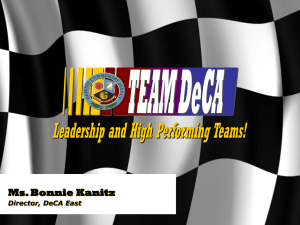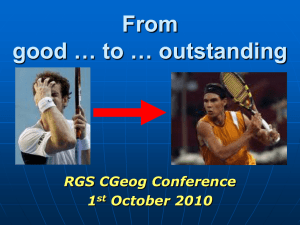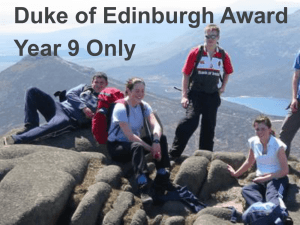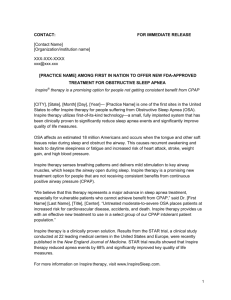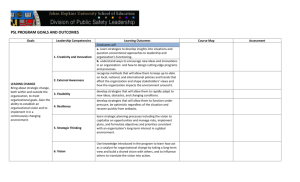uqol-data-dictionary-proposal
advertisement
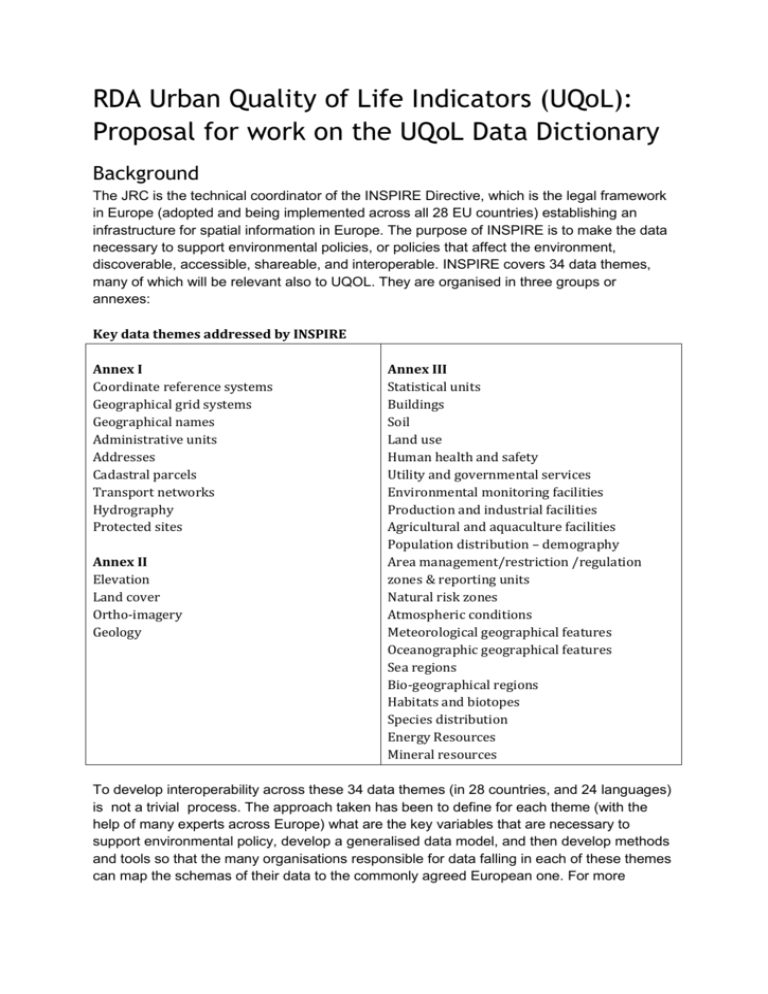
RDA Urban Quality of Life Indicators (UQoL): Proposal for work on the UQoL Data Dictionary Background The JRC is the technical coordinator of the INSPIRE Directive, which is the legal framework in Europe (adopted and being implemented across all 28 EU countries) establishing an infrastructure for spatial information in Europe. The purpose of INSPIRE is to make the data necessary to support environmental policies, or policies that affect the environment, discoverable, accessible, shareable, and interoperable. INSPIRE covers 34 data themes, many of which will be relevant also to UQOL. They are organised in three groups or annexes: Key data themes addressed by INSPIRE Annex I Coordinate reference systems Geographical grid systems Geographical names Administrative units Addresses Cadastral parcels Transport networks Hydrography Protected sites Annex II Elevation Land cover Ortho-imagery Geology Annex III Statistical units Buildings Soil Land use Human health and safety Utility and governmental services Environmental monitoring facilities Production and industrial facilities Agricultural and aquaculture facilities Population distribution – demography Area management/restriction /regulation zones & reporting units Natural risk zones Atmospheric conditions Meteorological geographical features Oceanographic geographical features Sea regions Bio-geographical regions Habitats and biotopes Species distribution Energy Resources Mineral resources To develop interoperability across these 34 data themes (in 28 countries, and 24 languages) is not a trivial process. The approach taken has been to define for each theme (with the help of many experts across Europe) what are the key variables that are necessary to support environmental policy, develop a generalised data model, and then develop methods and tools so that the many organisations responsible for data falling in each of these themes can map the schemas of their data to the commonly agreed European one. For more information see http://inspire.ec.europa.eu/index.cfm and more specifically http://inspire.ec.europa.eu/index.cfm/pageid/2 As part of this process, a key issues has been to agree on terms and definitions and publish them in the INSPIRE registry. http://inspire.ec.europa.eu/registry/ Many of these terms can contribute to the creation of an Urban Dictionary as set out in the WG case statement: The WG will assess the feasibility of developing a dedicated urban data dictionary, leveraging existing thesauri and dictionaries such as the INSPIRE feature concept dictionary, the General Environmental Multilingual Thesaurus, EuroVOC, etc. and augmented by folksonomies derived from social networks data mining. As part of the JRC research activities, we have already developed bridges between the INSPIRE Feature Concept Dictionary and other thesauri and vocabularies. With this in mind, we propose to start from this core set of aligned vocabularies and explore its feasibility as a framework for an UQOL Urban data dictionary. Proposal To assess the feasibility of developing a dedicated urban data dictionary, we propose to set up an online environment for the creation and maintenance of a knowledge base (KB), where WG members can: ● contribute existing thesauri ● identify relevant terms from existing thesauri ● contribute / create alignments across relevant terms from different thesauri ● create new thesauri. From the technological side, the proposal is to use Linked Data and Semantic Web tools and languages. In particular we propose to use SKOS1 for the representation of the KB’s content, and a triple store for its storage, maintenance, and access. The rationale behind this proposal is that (a) SKOS is currently a widely used standard for the representation of thesauri and semantic relationships, and (b) triple stores are specifically designed for storing Linked Data (as SKOS-encoded content is) and it supports a query language, SPARQL2, offering WG members the ability to effectively explore the KB’s semantic graph. Our contribution JRC can offer a contribution at two levels: Setting up and maintaining the triple store to store the knowledge base We plan to use OpenLink Virtuoso3, which offers the basic functionalities required for the knowledge base environment (KBEnv). 1 http://www.w3.org/TR/skos-reference/ http://www.w3.org/TR/rdf-sparql-query/ 3 http://virtuoso.openlinksw.com/ 2 WG members will be given specific access privileges to edit the KB. These operations will be carried out manually by using the Virtuoso frontend. Potentially, the knowledge base can also be edited via the SPARUL API (SPARQL Update4). The availability of this option will be considered in a later phase, based on use cases and requirements. Contributing in the creation of the knowledge base JRC can contribute a number of thesauri and alignments as a basis for the KB. In particular, we can contribute all the alignments created in the framework of the EU project EuroGEOSS5, which cover the following thesauri: ● ● ● ● ● ● ● INSPIRE themes6 and feature concepts7 GEMET8: The General Multilingual Environmental Thesaurus GEOSS Societal Benefit Areas9 GEOSS Earth Observation vocabulary EuroGEOSS Drought vocabulary10 GCMD Earth science keywords11 Cadastre and Land Administration Thesaurus (CaLAThe)12 These alignments, currently used in GEOSS, are available through the JRC’s SemanticLab SPARQL endpoint13 (HTML preview: http://bit.ly/1z1hLSu). Moreover, we can include in the KB the alignments developed by the EU Publications Office between EuroVoc14 and a number of other thesauri - including, AGROVOC15, GEMET and the INSPIRE themes. These alignments are available from the EU Open Data Portal.16 4 http://www.w3.org/Submission/SPARQL-Update/ http://www.eurogeoss.eu/ 6 http://inspire.ec.europa.eu/theme/ 7 http://inspire.ec.europa.eu/featureconcept/ 8 http://www.eionet.europa.eu/gemet/ 9 http://en.wikipedia.org/wiki/Societal_Benefit_Areas 10 http://ijsdir.jrc.ec.europa.eu/index.php/ijsdir/article/view/264 11 http://gcmd.nasa.gov/learn/keyword_list.html 12 http://www.cadastralvocabulary.org/ 13 http://semanticlab.jrc.ec.europa.eu:4433/sparql 14 http://eurovoc.europa.eu/ 15 http://aims.fao.org/agrovoc 16 https://open-data.europa.eu/en/data/dataset/eurovoc 5

